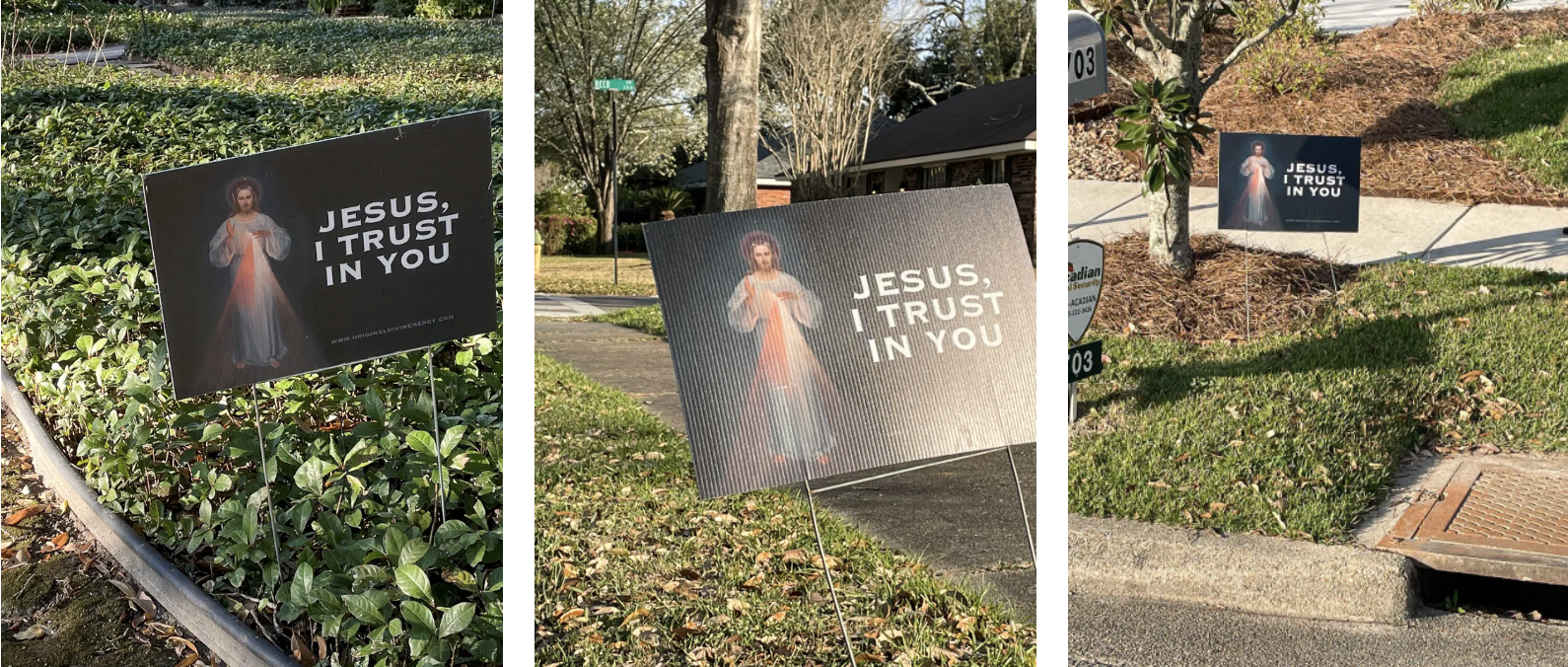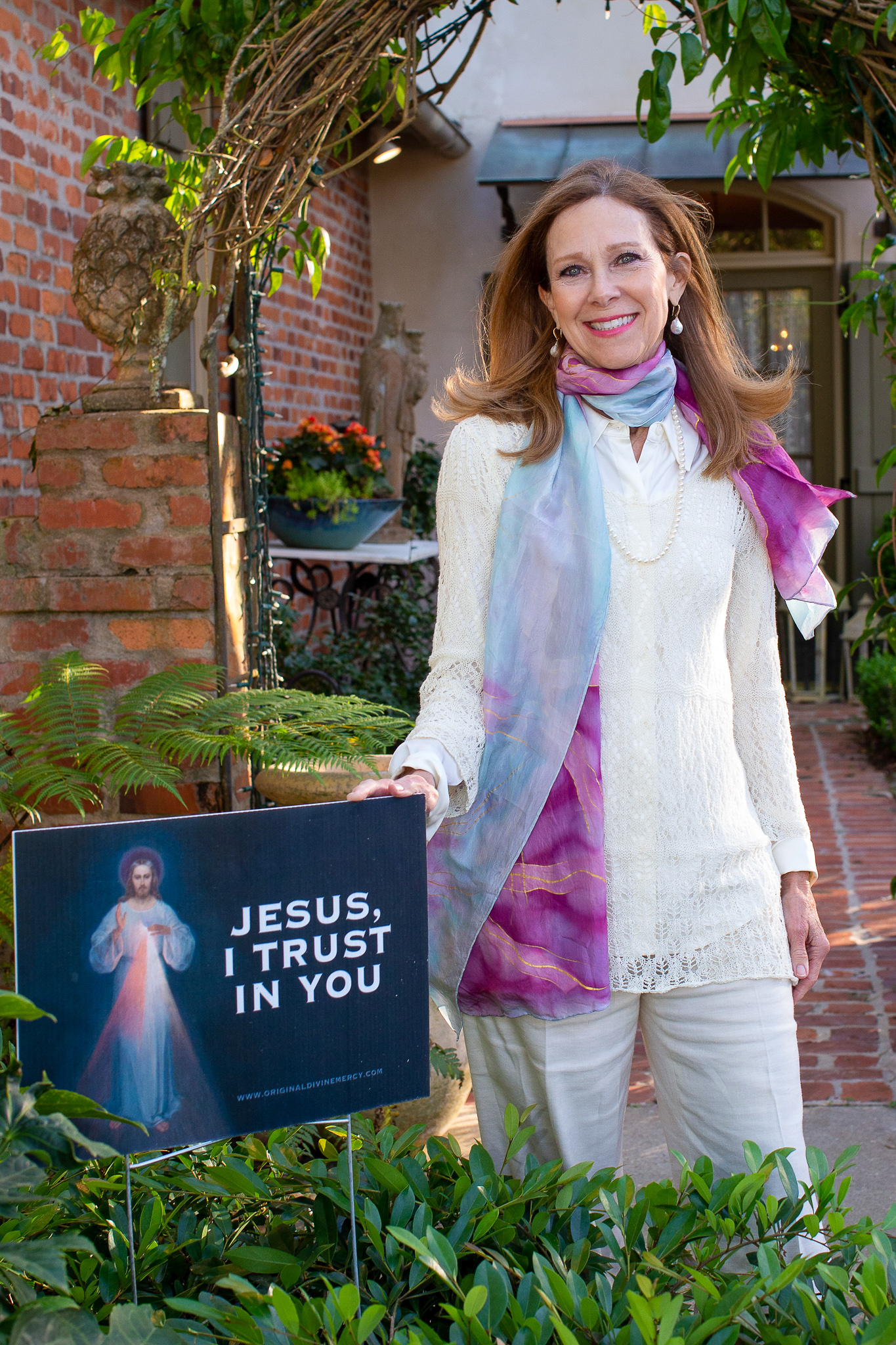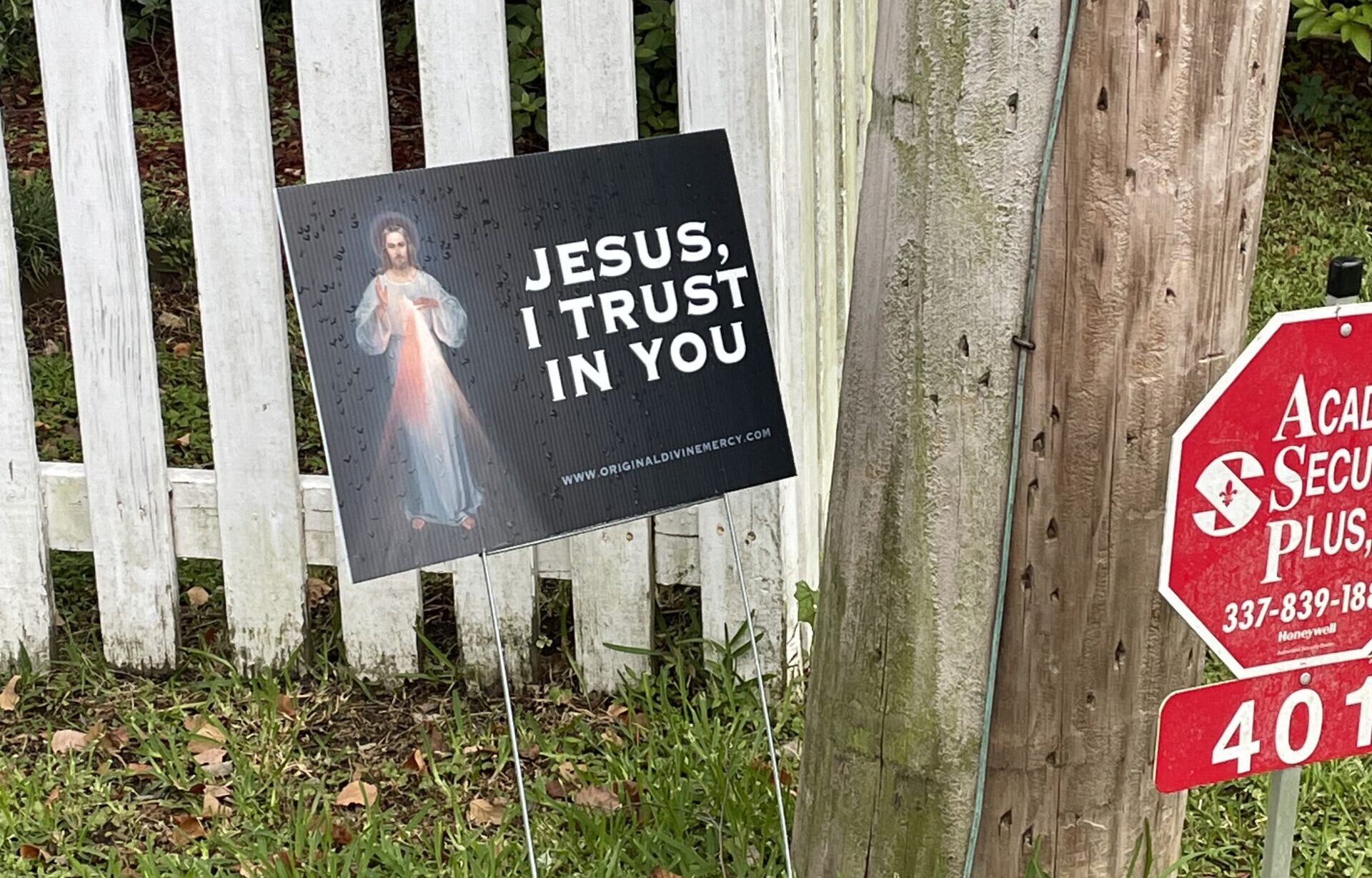Signs of hope in Lafayette?
Margaret Rucks is attuned to Lafayette’s needs. She identifies and directs charitable funding to local needs as managing director of the Rucks Family Foundation. Back in July of 2020 she discerned that Lafayette was in need. She recalls thinking, “We are in such dire times. People are losing hope. They’re despairing. They have a need of reminders.” Statistics backed up Ms. Rucks’ intuition. A published study by the School of Public Health concluded that depression among US adults jumped from 8.5 percent before the pandemic to 27.8 percent during the first months of the pandemic. This number increased to 32.8 in 2021. (See The Lancet Regional Health – Americas, Vol. 5 ,100091, January 01, 2022)
Inspired by a love for Christ and her hometown, Margaret set out to remind Lafayette of its hope. But, how to do this was not immediately obvious. She decided upon yard signs, the tried-and-true method of political campaigns and event planners. At first glance, Ms. Rucks does not appear to be the typical community or grassroots activist. She exudes refinement, speaks graciously, wears fashionable scarves, still handwrites “thank you” notes, and is a grandmother of six. Yet, Christ’s call leads many on missions that otherwise may be considered outside of their comfort zones.
Margaret next decided upon the signs’ content and message. Her long fondness for the famous “Divine Mercy” painting of Christ and its signature message, “Jesus, I trust in you” made it her obvious choice. After a quick web search, she found the Original Divine Mercy organization which produced yard signs with the “Divine Mercy” image and message.

The origin of the “Divine Mercy” painting is its own interesting story. Sister Faustina Kowalska, a Polish nun, wrote in her diary of visions of Jesus appearing to her beginning in 1931. Commissioned artist Eugeniusz Kasimirowski painted and presented the first depiction of Sister Faustina’s vision in 1934. Though other paintings have since been made, Kasimirowksi’s painting is considered the original since it is the only version seen by Sister Faustina before her death. The painting is roughly seven feet tall. It depicts Jesus blessing the viewer with a raised right hand with red and pale rays depicting blood and water flowing from His heart.
Daniel Disilva, with the Original Divine Mercy organization, has directed a documentary about both the history and meaning attributed to the painting. Mr. Disilva explained in speaking with Covenant Spotlight that the red ray represents Christ’s blood mercifully shed on the Cross, and the white depicts the cleansing of baptism. He explained that the message “Jesus, I trust in you” was the signature prayer that Sister Faustina related that Jesus had instructed her to accompany the painting. Mr. Disilva believes, “It is a short phrase that encompasses all of our movement of heart toward Christ in faith, in trust.” He explains that praying “Jesus, I trust in you” succinctly sums up Christ’s gospel and also mirrors the petitions of trust found in the Lord’s Prayer. The painting inspired the faithful during both World War II and the communist regimes in Poland according to Mr. Disilva. The Roman Catholic Church subsequently adopted Divine Mercy Sunday into its church calendar for the Second Sunday of Easter. The painting is today in Vilnius, Lithuania. With the eruption of war again in Europe, Mr. Disilva once again sees the historical need for this message of Christ’s hope.
Margaret ordered and gave her initial ten signs to family and friends. With blue eyes gleaming, she describes their reaction, “They were so moved that not only had I done that but so elated to have it because they were needing it too. I mean they were just downtrodden, people were just weary, just discouraged. So, they were so happy, they said ‘Where did you get this? How can I get them?’” After planting one in her yard as a reminder of her “source of strength” and “refuge”, Margaret’s grass roots mission to spread hope to Lafayette took off. The next order of 300 signs was quickly distributed by many who had received the first ten. Next, she contacted her pastor and friends at other churches. Soon, volunteers distributed and signs popped up in yards from Woodvale, West Bayou Parkway, the Saint Streets, and throughout Lafayette.
Testimonials offer a glimpse into the success of Margaret’s mission of hope. Local resident Garrett Broussard sees the signs as his way of sharing the gospel, “My neighbors who are no longer Catholic and know the story of Sister Faustina, but still wanted a sign for their yard. The sign still resides in full view today. I think the complete simplicity of the sign and message is hard to deny and is in many ways bridging gaps between all the different Christian groups.”
For Gail Abshire, the Divine Mercy signs gave her peace as they reminded her of God’s ultimate control. Similarly, Elizabeth Ortte, also of Lafayette, explains that when she sees the signs, “I am daily reminded to put my trust in Jesus.” Steven Neef, a volunteer in distributing the signs, remembers one particular experience. A mother and child in a stroller approached him. Asking for a sign, he quickly obliged the request. He learned that she was staying in Lafayette with a relative having been displaced from Lake Charles by Hurricane Laura. She requested that signs be placed in her Lake Charles’ storm wrecked neighborhoods. Through Margaret’s mission, two thousand five hundred have been distributed to Lake Charles since Hurricane Laura.
Margaret hopes to continue distributing, posting, and re-posting signs throughout Lafayette and Acadiana. She established an email (ProjectDivineMercy@gmail.com) for those interested in placing signs. Mr. Disilva notes only eleven other communities in the country have placed an individual order of at least 1,000 signs. He notes that where such orders are made hundreds of individual orders typically follow. Margaret’s latest presentation has included electronic billboards at multiple Acadiana locations. She relates this came about through a cooperative effort with an enthusiastic Stephen Sonnier, owner of Bass Ltd. Billboards. Plans for further expansion into billboards are underway.
While Christian traditions differ on the use of images, the “Jesus, I trust in You” prayer represents an ecumenical confession that both Evangelicals and Roman Catholics can embrace. The prayer is more than an intellectual assent to Jesus. It requires more than a mere appreciation of His teachings. To sincerely say the prayer requires self-reflection: “Am I trusting Jesus?” The prayer calls one to humble dependence and submission to Him by grace. Without arrogance or condemnation, the “Divine Mercy” prayer distinguishes itself from certain other “Christian” sloganeering. Finally, while over the past two years many churches were not meeting, the signs helped dispel in a small way the sense of isolation some local believers felt. They remind the faithful of Lafayette that they are not alone.
For Margaret Rucks, the prayer causes her to “remember that He is ever closely united to us in all the darkness that we might see around the world. When I see, ‘Jesus, I trust in you’, no matter what I am confronting that day, sign after sign diffuses the struggle, diffuses the obstacle. It reminds me that He is there, He’s never forsaken us, He’s not going to. People need to be reminded of this. They forget this. We get so overwhelmed and consumed with all of the negativity that we forget that He is with us.”
C.S. Lewis depicts hell in his novel The Great Divorce as a grey city whose residents are doomed to a state of quarrelsome isolation, self-absorption and hopelessness. While Margaret’s yard signs cannot rescue that city of despair, Scripture promises that the gates of hell shall not prevail (Mt. 16:18) where the gospel message takes hold. For Lafayette, Margaret’s mission is a sign of that hope.



